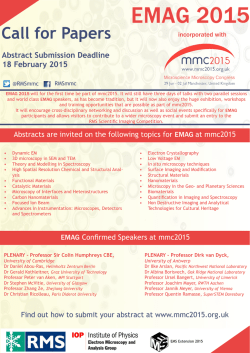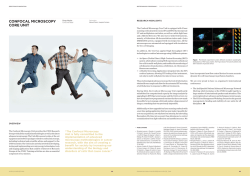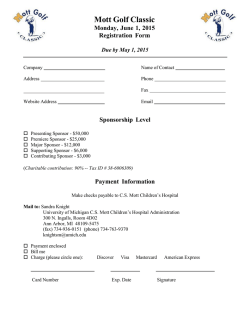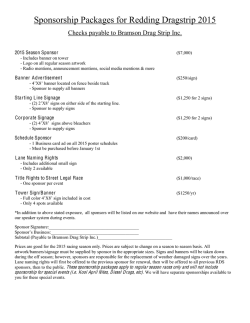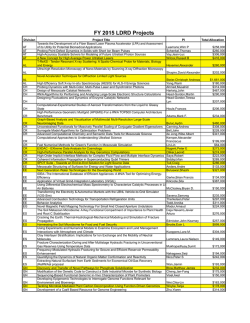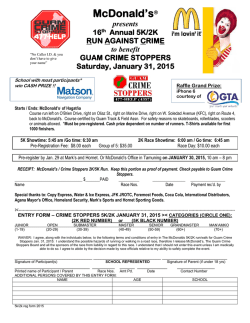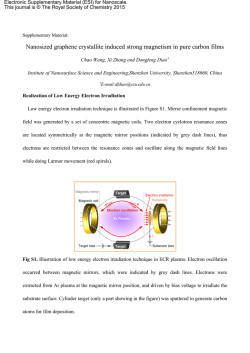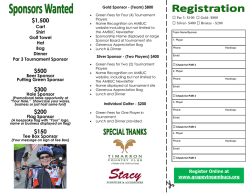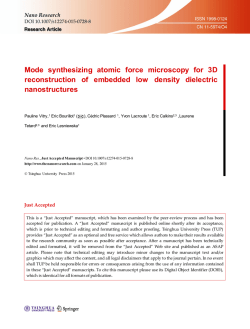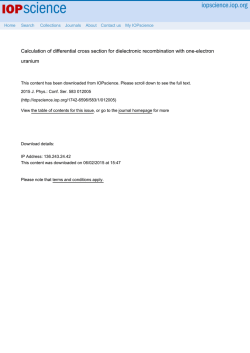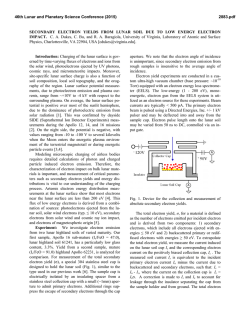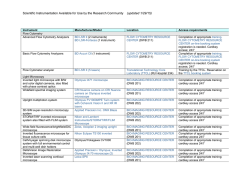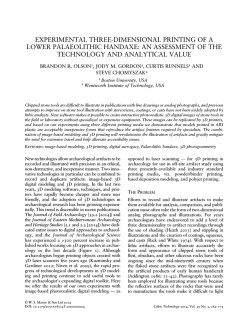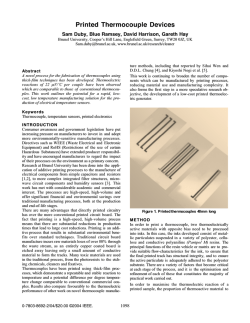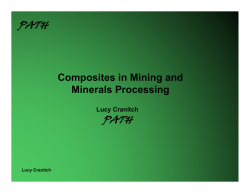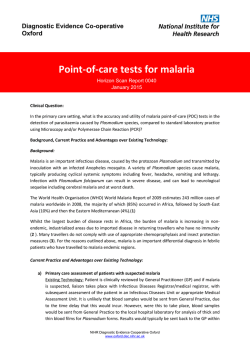
SCSMM - February 7, 2015 Spring Symposium Announcement
Full-Day Symposium Saturday February 7, 2015 California Institute of Technology BECKMAN INSTITUTE at Caltech LAS Sponsored Speaker: Kent McDonald Happy New Year to all SCSMM members! For our spring meeting 2015, we will return to the Beckman Institute at Caltech on February 7, 2015. We are very happy for you to enjoy the exceptionally beautiful campus and great meeting facilities once again. We are very excited to announce our 2015 LAS tour speaker, Kent McDonald, the director of the Electron Microscopy Lab at the University of California, Berkeley. His vast expertise includes a great variety of techniques used for state-of-theart life-science imaging, including correlative microscopies, cryo-fixation, serial thin sectioning as well as cellular tomography. I would especially like to highlight the great contributions from our San Diego society members. This year, we welcome another speaker from San Diego: Dr. Elizabeth Wilson-Kubalek (Scripps Institute). In past years we have had outstanding speakers from the San Diego area, such as Timothy Baker (UCSD), Thomas Deerinck (NCMIR), Dorit Hanein (Sanford Burnham), and Arne Moeller (Scripps). We truly appreciate the long trip from San Diego, and for contributing research of the highest standard to the SCSMM. We also welcome our other outstanding speakers: Simon Ramo Professor of Materials Science, Katherine Faber (Caltech), former SCSMM President John Porter (UES Inc., Ohio), and Dr. Elitza Tocheva (Caltech/University of Montreal). Additionally, we will have a student session as well as a poster session. Once again, there will be a $500 award for the best platform presentation and $300 award for the best poster. These awards are to support travel to the national M&M Meeting, this year to be held in Portland, Oregon (August 2-6, 2015). As always, our meetings and low membership dues are only possible due to our generous sponsors. We couldn't do it without their support, so please take time to talk to the vendor representatives at our spring meeting. Thank you for your continuous support! Besides working on organizing meetings, the Board has also worked hard to modernize our website (http://www.scsmm.org), and we are now also on facebook! And last but not least, we are excited to announce our first image contest! Send us your most visually stunning images from any type of microscope for a chance to win one of five $10 gift cards! We will announce the winners at our Spring Meeting on February 7. The contest is open to both members and non-members. Please email your entries to the President of SCSMM ([email protected]) until January 31. The images should be in tif, jpg or pdf format, with at least 300dpi resolution. Please provide name, title, short description, and institution. The images will be displayed on the website https://scsmmimages.wordpress.com as well as on our Facebook page, and judged by the SCSMM board imaging committee. The image with the most likes on Facebook will get the popularity award with a $20 starbucks gift card. I hope to see you all on February 7 at Caltech. Ariane Briegel, President. Spring meeting 2012 at Caltech Posters displayed around the reflecting pool SCSMM 2015 Spring Symposium Schedule 8:00 - 9:00 Registration 9:00 - 9:10 Welcome Address 9:10 - 9:55 LAS tour speaker Cellular Electron Microscopy Methods for a New Generation: Rapid Specimen Preparation Procedures for Resin Embedding of Cryofixed Biological Samples Kent McDonald, University of California, Berkeley 9:55 - 10:25 Structural comparison of the Human and C.elegans Ndc80 Complex Liz Kubalek, The Scripps Research Institute 10:25 – 10:40 PRIAS – Turning Your EBSD Detector Into a Powerful Imaging Tool Matt Chipman, EDAX Inc. 10:40 – 11:00 Coffee Break 11:00 – 11:30 Probing Pore Space: Three-Dimensional Analysis of Porous Ceramics Kathy Faber, California Institute of Technology 11:30 – 12:00 In-situ Deformation of Additively Manufactured Ti 6Al 4V John Porter, UES Inc. 12:00 – 12:15 New Novel Analytical Tools for SEMs Brian Miller, Bruker AXS 12:15 – 13:15 Lunch break 13:15 – 13:30 Business meeting 13:30 – 14:45 Student Presentations 14:45 – 15:00 Patrick Minnella, EMS 15:00-15:45 Coffee Break and Poster Session 15:45 – 16:15 Electron Cryotomography of the Bacterial Cell Envelope Elitza Tocheva, California Institute of Technology 16:15 – 16:45 Student Awards Presentations and Photo-Contest winner’s announcement Directions Exit the 210 Freeway westbound at Hill Ave. or eastbound at Lake Ave. Go south to Del Mar Blvd. From Hill, turn right (west); from Lake turn left (east). Proceed to Wilson Ave. and turn south on Wilson. Park in the first parking structure on the right. Do not park in any space that has a name on it or says “carpool”. The Beckman Institute is just across the street from the parking structure. There is a map available at: http://www.caltech.edu/map. The parking structure is #123 and the Beckman Institute is #74. You may also locate the building on Google Maps or on your GPS by using the following co- ordinates: 34°08'20.98" latitude, -118°07'36.29" longitude. Registration & RSVP Advanced reservation is required. The event is limited to 100 participants. Due to the generous support of our corporate members, registration for this meeting is included in the membership dues. Respond no later than 5 p.m. on January 29, 2015 Please contact Mark Armitage [email protected] Regular annual membership for the 2014-2015 term is $25 and $10 for students. For further details visit SCSMM web site www.scsmm.org Abstracts Cellular Electron Microscopy Methods for a New Generation: Rapid Specimen Preparation Procedures for Resin Embedding of Cryofixed Biological Samples Kent McDonald University of California, Berkeley In the past few years my laboratory has been exploring alternatives to the conventional lengthy procedures used to fix and embed cells for cellular electron microscopy (microscopy of whole cells and tissues). We start with cells frozen by high pressure freezing, then dehydrate and stabilize the ultrastructure by freeze substitution (FS). We have reduced the time for FS from several days to a few hours. Resin infiltration and embedding is done in 2-3 hours with no special equipment. We also have a new method for on-section immunolabeling by doing FS with uranyl acetate in acetone and embedding in LR White. FREEZE SUBSTITUTION. As described in McDonald and Webb [1] we now do FS using simple, inexpensive equipment instead of a costly automated freeze substitution (AFS) device. Briefly, frozen samples are placed in cryovials containing frozen fixative and placed in a metal block cooled to liquid nitrogen temperature. The metal block is placed in a foam box that is then put on a rotary shaker operating at 100-125 rpm. The samples are warmed up passively over 2-3 hours to room temperature at which point the fixative is rinsed out and the embedding process is begun. RESIN INFILTRATION AND POLYMERIZATION. We used to do quick processing using a microwave oven but wanted rapid procedures that did not require this expensive equipment. We found that microwaves were not actually necessary and also discovered that rapid embedding procedures were not new [2]. Briefly, we do a stepwise increase in epoxy resin:acetone concentrations from 25, 50, & 75%, then 3 times in pure resin for 5-15 minutes each with centrifugation at 2,000 x g for 30 seconds to a minute in between changes. Polymerization is at 100 degrees C for 2 hours. While we can go go from live cells to sections in the microscope in one working day, in practice we often freeze, FS, and embed on one day and section and look at the samples the next. Results from a variety of cell and tissue types is shown in recent publications [3,4]. ON-SECTION IMMUNOLABELING. Specimens are freeze substituted in 0.2% uranyl acetate in acetone to room temperature, then rapidly embedded as above in LR White which is polymerized at 100 degrees C for 90 minutes. The advantage of not using traditional fixatives is that more antibodies are likely to work at the EM level because aldehyde fixatives are not blocking their access to antigens. [1] [2] [3] [4] McDonald, K. & R. Webb. 2011. J. Microscopy 243:227-233. Hayat, M.A. & R. Giaquinta. 1970. Tissue and Cell 2:191-195. McDonald, K. 2014. Microsc. Microanal. 20:152-163. McDonald, K. 2014. Protoplasma 251:429-448. Structural Comparison of the Human and C.elegans Ndc80 Complex Elizabeth Wilson-Kubalek The Scripps Research Institute The Ndc80 complex is a widely conserved assembly that plays a key role in kinetochore-microtubule attachment during mitotic spindle assembly and chromosome segregation. This four-subunit, “dumbbell”-shaped complex is anchored to the kinetochore via its SPC24/25 globular domains, while the Ndc80/Nuf2 globular heads bind the dynamic spindle microtubules. To further our understanding of the mechanism of Ndc80-microtubule attachment, we used cryo-electron microscopy to examine the binding mechanisms of human and C.elegans Ndc80 complex to microtubules. Comparison of the sub-nanometer resolution maps showed some surprising differences. The human Ndc80 complex bound the microtubule with a tubulin monomer repeat, interacting at both intra and inter-tubulin dimer interfaces whereas the C.elegans Ndc80 complex binds strongly at the interface between dimers and weakly at the adjacent intradimer. These differences reveal significant insights into the complicated Ndc80 binding mechanism, and pose new questions for future studies. Probing Pore Space: Three-Dimensional Analysis of Porous Ceramics Katherine T. Faber California Institute of Technology Interconnected porosity plays important functions in ceramic components, from modifying electrical, mechanical and thermal properties to serving as a transport phase. Applications that require porous solids include filters, catalysts and catalyst supports, heat exchangers, composite preforms, and biomedical implants. Characterization of the volume fraction, size, morphology and connectivity of porosity in engineered components is vital for understanding pore effects on material properties and for optimizing processing conditions to yield desired microstructures, and hence, properties. In this presentation, pore size, connectivity and tortuosity of three porous systems – a gelcast Al 2O3 model system, an acicular mullite (3Al 2O3.2SiO2) used as a particulate filter, and a Liion battery’s LiCoO3 cathode – are evaluated using three-dimensional data sets produced using synchrotron X-radiation or focused-ion beam-scanning electron microscopy. Methods for calculating tortuosity are compared and their relative merits appraised. Pore network-property relations also are discussed. In-situ Deformation of Additively Manufactured Ti 6Al 4V John Porter, Robert Wheeler and Michael Velez UES Inc., Dayton, OH Electron Beam Melting additive manufacturing of Ti 6Al 4V results in an alpha/beta microstructure consisting of columnar prior beta grains that have mostly transformed to alpha on cooling from the build temperature. Here, we have used a microtensile test rig in an SEM to measure mechanical properties from within one prior beta grain in both the longitudinal and transverse directions as well as across a prior beta grain boundary. The implications for additively manufactured parts will be addressed. Electron Cryotomography of the Bacterial Cell Envelope Elitza I. Tocheva and Grant J. Jensen California Institute of Technology Bacteria can be divided into two major types based on their cell envelope architecture. A single cytoplasmic membrane and a thick layer of peptidoglycan (PG) surround Gram-positive bacteria whereas an inner and outer membranes and a thin layer of PG surround Gram-negative bacteria. Electron cryotomography was used to study the complex morphological changes that occur in the bacterial cell envelope during endospore formation. Endospore formation begins with asymmetric cell division. Next, similar to phagocytosis, the bigger compartment (mother cell) engulfs the smaller compartment (spore). Multiple protective layers are formed around the immature spore before the lysis of the mother cell releases the mature spore. We used Bacillus subtilis as a model Gram-positive sporulator and our recently identified Acetonema longum as a model for Gram-negative sporulator. Tomograms of vegetative, sporulating and germinating B. subtilis and A. longum cells revealed that two membranes surround the mature spores in both cell types. Both spore membranes originate from either the cytoplasmic (B. subtilis) or the inner membrane (A. longum) of the mother cell. During germination, B. subtilis loses its outer spore membrane to become a single-membraned vegetative whereas A. longum retains it and converts it from an inner-like to a true outer membrane. Further structural analyses revealed that PG is continuous in both cell types throughout sporulation and is remodeled from thin to thick and back to thin. These structural changes together with the homologous synthetic machinery reveal a conserved PG architecture between Gram-positive and Gram-negative bacteria. Altogether, our cryotomography results coupled with genomic and biochemical analyses point to two major conclusions of evolutionary significance: 1) sporulation may have given rise to outer membrane in bacteria, and 2) both Gram-positive and Gram-negative bacteria share the same basic PG architecture. Membership Application 2014 - 2015 Membership Valid Through August 31, 2015 Name: ______________________________________________________________________ Institution: __________________________________________________________________ Address: ____________________________________________________________________ ______________________________________________________________________________ City, State Zip_______________________________________________________________ Phone: ______________________________________________________________________ E-mail address: _____________________________________________________________ Web Site: ___________________________________________________________________ Please check the appropriate membership category: Regular @ $25.00 Student @ $10.00 Corporate @ $100.00 Corporate Memberships are entitled to two individual member listings. If you have selected a Corporate Membership, please copy this form and provide details for the second listing. Write “2nd Listing” at top of form. Please attach a check for the appropriate amount made payable to SCSMM. You may bring this form along with your dues to any of our meetings or mail to: SCSMM c/o Mark Armitage Micro Specialist 587 E North Ventu Park Road #304 Thousand Oaks, CA 91320 SCSMM Vendor Sponsorship Benefits and Recognition $500 • • • • • (Gold) level Instrumentation display during spring meeting (table). Scheduled (15 min) talk during spring or fall meeting. Announcement/acknowledgment from the stage as a Gold sponsor of SCSMM. Listing as a Gold sponsor in all press and media materials of the SCSMM. Invitation for two to attend the spring and fall meeting. $250 (Silver) level • Instrumentation display during spring meeting (table). • Announcement/acknowledgment from the stage as a Silver sponsor of SCSMM. • Listing as a Silver sponsor in all press and media materials of the SCSMM. • Invitation for two to attend the spring and fall meeting. $150 (Bronze) level • Announcement/acknowledgment from the stage as a Bronze sponsor of SCSMM. • Listing as a Bronze sponsor in all press and media materials of the SCSMM. • Invitation for two to attend the spring and fall meeting. $100 Regular Corporate membership • Listing as a Corporate Member in SCSMM spring and fall pre-meeting newsletters. • Invitation for one to attend the spring and fall meetings. Vendors are also most welcome to sponsor with "in-kind" support of our meetings, such as providing wine with dinner (fall meeting) or a prize for a raffle or student talk/poster. Acknowledgments of such sponsorship will be made during the meeting and in the meeting announcement - and are always much appreciated! *Sponsorship is effective and recognized by SCSMM only for the year it was made (starts in the fall) and only after vendor’s contribution has been received. The Southern California Society for Microscopy and Microanalysis wishes to acknowledge the following Corporate Members who faithfully advertise in our Meeting Announcements, sponsor meetings and have renewed their commitment to our society for the 2014 - 2015 year. Chad Tabatt Gatan Inc. (925) 548-4865 [email protected] Chris Rood JEOL USA, Inc (760) 476-1747 [email protected] Matt Chipman EDAX Inc. (801) 495-2872 matthew.chipman @ametek.com Patrick Minnella EMS/Diatome (215) 412-8400 [email protected] Jeff Larson Hitachi High Technologies America (858) 386-8244 Jeffrey.larson @hitachi-hta.com Brian Miller & Don Becker Bruker AXS (608) 347-6050 brian.miller @bruker-axs.com Drew Erwin Tescan USA (925) 325-8978 drewerwin @tescan-usa.com Joe Robinson Thermo Fisher Scientific (503) 327-9256 joseph.c.robinson @thermofisher.com Melissa Dubitsky & Hyun Park Tousimis Research Corp. (301) 881-2450 [email protected] Ben Jacobs & Robert Monteverdi Protochips, Inc (517) 980-1170 [email protected] Tony Carpenter FEI Company (480) 650-8190 [email protected] Steve Pfeiffer RMC/Boeckeler (503) 396-2810 [email protected] Mark Mobilia and KD Derr Carl Zeiss Microscopy LLC (800) 543-1033 x7161 [email protected] [email protected] Sheri Neva Evans Analyitical Group (310) 322-2011 [email protected] Aaron Drake Oxford Instruments (925) 215-8911 [email protected] Robert Stroud NanoMegas USA (208) 867-0142 [email protected] Andrew King Renishaw (760) 494-0279 Andrew.King @renishaw.com David Platus Minus K Technology (310) 348-9656 [email protected] Jack Vermeulen Ted Pella, Inc. (800) 237-3526 [email protected] Ed Rezler Device Analytics, LLC (760) 635-0047 erezler@ deviceanalytics.cm Your SCSMM Board President Ariane Briegel [email protected] Vice President Physical Jian-Guo Zheng Vice President Biological Zhuo Li Past President Secretary Treasurer Vendor Relations [email protected] [email protected] Sergey V. Prikhodko [email protected] Mike Pickford [email protected] Mark Armitage [email protected] Chris Rood [email protected] Executive Council Biological Yi-Wei Chang Executive Council Physical Krassimir N. Bozhilov [email protected] [email protected]
© Copyright 2025
